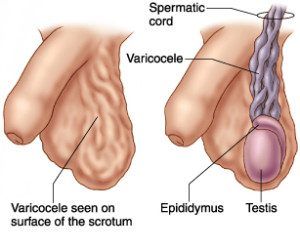
Finding a lump in your testicles can be a frightening experience. If you’re diagnosed with a varicocele, your first reaction may be relief. However, varicoceles can have a significant impact on your health. Left-sided varicoceles are common. If your varicocele is on the right side of your scrotum, this may be a sign of a serious underlying medical issue. Read on to learn more about right-sided varicoceles and varicocele treatment options.
What’s a Varicocele?
A varicocele is a varicose vein that develops in the scrotum. Causes of a varicocele can vary. Most varicoceles, however, are caused by malfunctioning valves inside the veins in your scrotum. [i]
Your veins have valves that keep blood flowing in the right direction. Sometimes, these valves don’t work as they should. Instead of pumping blood back to the heart, blood pools in the vein. Over time, the vein can become swollen and enlarged. [i]
Should I Worry About My Varicocele?
A varicocele is often detected during a routine testicular exam. You may be able to see or feel your varicocele when you perform a self-exam. Your scrotum may look or feel lumpy, or you may see raised veins.
It’s true that varicoceles usually aren’t a sign of a life-threatening health issue. That doesn’t mean that varicoceles can’t have a major impact on your life. Varicoceles can be very painful and testicular pain may keep you from enjoying an active lifestyle. They can also affect your sperm production and sperm quality. [ii] If you and your partner are struggling to conceive, you may need treatment to help restore your fertility.
Why Are Left-Sided Varicoceles More Common?
Most varicoceles develop on the left side of the scrotum because of the way your veins in your body connect to each other. The veins that supply blood to the testicles travel through your abdomen to join with the testes. As blood exits the testes, the right testicular vein joins with the inferior vena cava. The left testicular vein joins with the left renal vein. [iii]
Gravity can work against the blood traveling through the left renal vein, so it’s more likely to develop a varicocele on this side. Left testicle pain is one of the most common symptoms of a varicocele. In rare cases, though, you may experience a varicocele on the right side.
Are Right-Sided Varicoceles Dangerous?
Right-side varicoceles aren’t always a sign of a serious health problem, but they can be a sign that something is abnormal. Right-side varicoceles may suggest a blockage in your abdomen. [ii] These blockages can result from blood clots, tumors, or problems with your internal organs.
In some cases, a right-side varicocele can be a sign of adrenocortical carcinoma. [iv] These cancerous tumors affect the adrenal glands located above your kidneys. Fortunately, these tumors are rare. If you have a right-sided varicocele, your doctor may order several tests to check your abdomen.
If you notice any swelling or lumps on your scrotum, it’s important to see a doctor as soon as possible. Be sure to report any symptoms that seem to be affecting the right side of your scrotum. If your doctor doesn’t order any follow-up tests, don’t hesitate to seek a second opinion. A specialist can help you evaluate your risk for tumors or vascular blockages.
What Tests Might My Doctor Recommend?
Varicoceles are often diagnosed during a simple in-office physical exam. If your doctor has doubts about the diagnosis, he or she may recommend a scrotal ultrasound. This test can confirm a varicocele diagnosis. If you have a right-side varicocele, your doctor may opt to run a few other imaging tests. An ultrasound or CT scan allows your doctor to check for tumors or other masses in the abdomen.
What Are My Treatment Options?
If your varicocele is caused by an abdominal mass, your doctor may refer you to a specialist for further care. Surgery can help remove the obstruction and restore healthy blood flow to the scrotum.
If there are no abnormal masses in your abdomen, your treatment plan is usually much more straightforward. Your varicocele may not cause any painful symptoms or fertility issues. In that case, your doctor may recommend watchful waiting. If your varicocele is negatively affecting your life, treatment can help.
The goal of varicocele treatment is generally to close off the affected vein, or veins. [ii] Blood flow is then re-routed through healthy veins. The swollen vein shrinks and disappears over time. Open surgery and laparoscopic surgery are both an option as is a minimally invasive procedure called varicocele embolization.
Understanding Varicocele Embolization
During a varicocele embolization, a vascular specialist makes a tiny incision near your groin. Next, they insert a thin catheter through an artery in your leg and into the affected vein in your scrotum. The vascular specialist injects a special material into the vein. This material irritates the tissue lining the vein, and the vein scars and closes off. As a result of the closure of the affected vein, the blood flow is re-routed through healthy veins, and the varicocele disappears. [v]
Varicocele embolization is usually performed as an outpatient procedure with a short recovery time and a lower risk of complications than open surgery. Most men are able to return to their jobs or other activities within just a few days. Varicocele embolization has a 90% success rate, comparable to most surgical procedures. [vi] This procedure offers the best of both worlds: successful treatment combined with a quick recovery.
Ready to learn more? Download our free information sheet, Exploring Your Varicocele Treatment Options. Then call 866.996.9729 to schedule an appointment with a vascular specialist today.
Sources:
i Mayo Clinic. (2017, December 27). Varicocele: Symptoms & causes. Retrieved March 1, 2019, from https://www.mayoclinic.org/diseases-conditions/varicocele/symptoms-causes/syc-20378771
ii John Hopkins Medicine. Varicocele. Retrieved March 1, 2019, https://www.hopkinsmedicine.org/healthlibrary/conditions/kidney_and_urinary_system_disorders/varicocele_22,Varicocele
iii Warde, P. R., Hogg, D., & Gospodarowicz, M. K. (2012). Testicular cancer. In Gunderson, L. & Tepper, J. (Eds.), Clinical Radiation Oncology(3rd ed.pp. 1125-1144). Philadelphia, PA: Elsevier.
iv Cheungpasitporn, W., Horne, J. M., & Howarth, C. B. (2011). Adrenocortical carcinoma presenting as varicocele and renal vein thrombosis: A case report. Journal of Medical Case Reports, 5:337. doi:10.1186/1752-1947-5-337
v John Hopkins Medicine. Varicocele embolization. Retrieved March 1, 2019, from https://www.hopkinsmedicine.org/healthlibrary/test_procedures/urology/varicocele_embolization_135,383
vi Halpern, J., Mittal, S., Pereira, K., Bhatia, S., & Ramasamy, R. (2015, December 8). Percutaneous embolization of varicocele: Technique, indications, relative contraindications, and complications. Retrieved March 1, 2019, from https://www.ncbi.nlm.nih.gov/pmc/articles/PMC4770492/